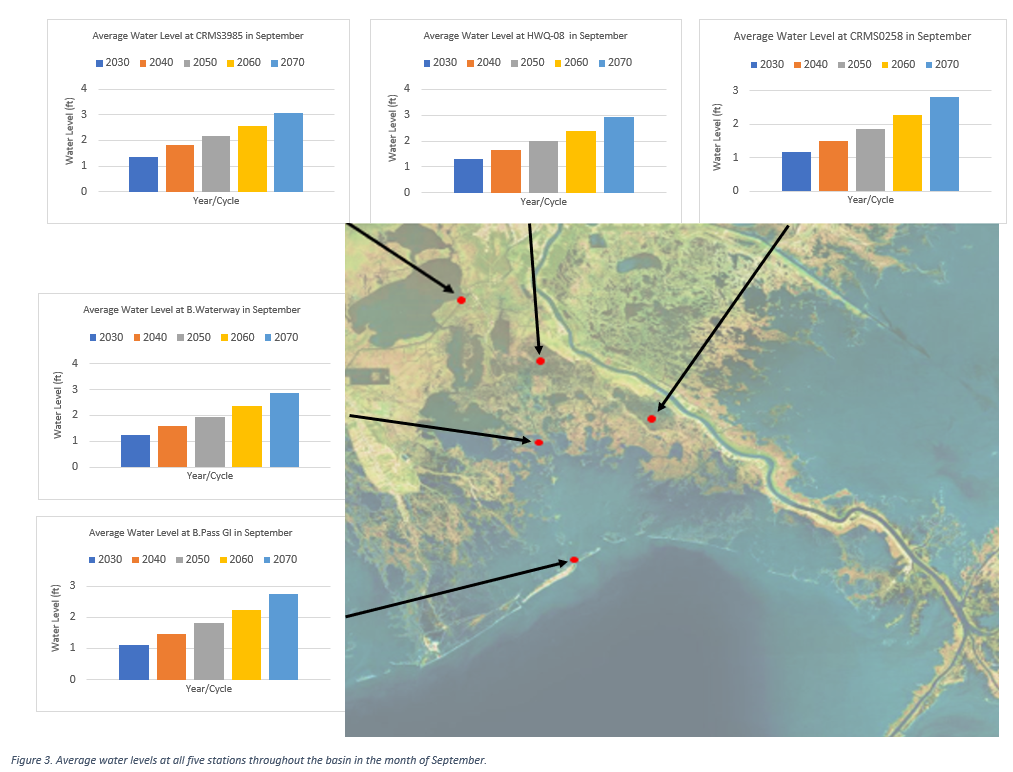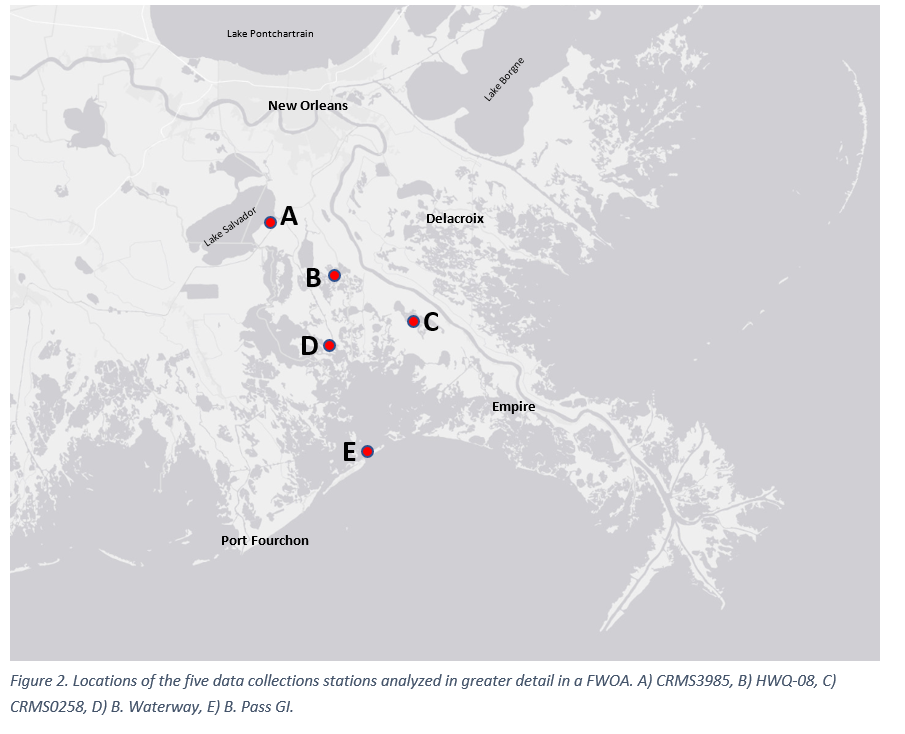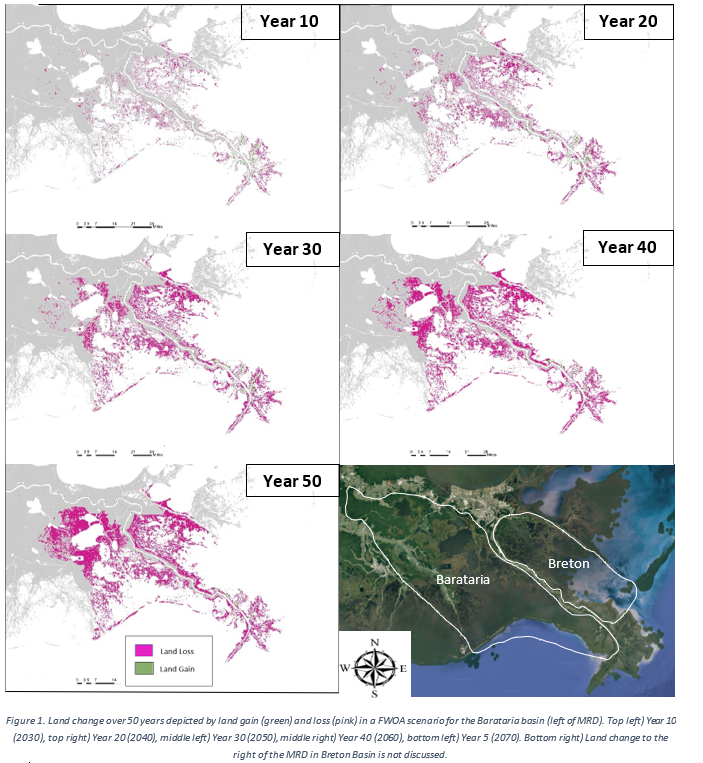Without the Mid-Barataria Sediment Diversion, the Future for Louisiana’s Barataria Basin is Bleak
Louisiana’s land loss crisis is dire and will significantly worsen without investments in large-scale coastal restoration and protection projects. Since the 1930s, Louisiana has lost 2,000 square miles of coastal wetlands. Without action, the state could lose double that amount — an additional 4,000 square miles of land – in the next 50 years. This future scenario, commonly referred to as Future Without Action (FWOA), underscores why Louisiana has literally no time to lose in constructing coastal projects that can protect communities, businesses, wildlife and vital natural resources.
Louisiana’s Coastal Restoration and Protection Authority (CPRA) is making significant progress in addressing this land loss crisis, and looking at the FWOA underscores why this work is so crucial.
Through the Sediment Diversion Operations Working Group, we analyzed key locations in Barataria Basin to better understand what a FWOA could mean. Like much of Louisiana’s coast, Barataria Basin will change significantly over the next 50 years. However, our analysis found there will be significant changes without a sediment diversion in the basin.
Here are at least 5 ways Barataria Basin will change over time without a sediment diversion:
1. Barataria Basin will lose an increasingly large amount of land
Without action, the Barataria Basin will lose an extreme amount of land – to the tune of 550 square miles over the next 50 years. Wetlands will erode and convert to open water as the Gulf of Mexico intrudes further inland, barrier islands and interior marshes will virtually disappear, communities will become increasingly vulnerable to flooding from hurricanes and sea level rise, and significant shifts in habitat and vegetation will threaten wildlife and the entire ecosystem. It is not to say that with a diversion land loss and rising seas won’t occur, but under a FWOA, that loss will be significantly greater. A diversion will provide a tool capable of adapting to sea level rise over time.
2. Water levels will rise significantly, greatly increasing flooding and risk to communities
One of the most important and alarming results to come from this analysis is that water levels may double over the next 50 years at each location. The rise in water levels to near or above 3 feet could result in more frequent flooding events, longer inundation periods, and increased risk to communities, levee systems and evacuation routes. Additionally, elevated water levels will submerge marshes for longer periods of time, killing vegetation and inducing greater wetland loss. With exacerbated sea level rise and wetland loss along the coast, communities will need to adapt to this new normal with an increasing number of flood challenges or move to higher and safer ground. Levee systems and evacuation routes will need to be upgraded and elevated to ensure protection from future storms and provide safe escape routes for residents.
 3. The diversity and abundance of vegetation decreases dramatically, threatening the health and stability of the entire ecosystem
3. The diversity and abundance of vegetation decreases dramatically, threatening the health and stability of the entire ecosystem
As conditions change over time, so does the diversity of vegetation in the basin. For example, at the easternmost location saltmeadow cordgrass (Spartina patens), smooth cordgrass (Spartina alterniflora), and submerged aquatic vegetation (SAV) show a decrease in coverage over 50 years due to land loss. Diversity of species such as these are important to the health and stability of an ecosystem. They can influence environmental factors like soil stability, hydrology, and primary production to name a few, which often benefits other parts of the estuarine food web. More saline vegetation, which are inherently less diverse compared to fresh, will be present in a FWOA in the southern portions of the basin. A diversion can help maintain a diversity of vegetation, which will benefit the entire ecosystem.
4. Salinities increase dramatically, impacting many fish and wildlife species throughout the basin
Salinities rise considerably throughout the 50 years at stations in the southern portion of the basin near the Gulf of Mexico. This could have impacts to the ecological system particularly for species that require fresher conditions to survive during some part of their life history such as blue crab, brown and white shrimp, and bay anchovy. Increases in salinities could impact spawning, migration, health and predation of specific fish species. Salinity spikes will also likely kill fresh vegetation, causing further habitat loss and wetland erosion. If constructed, a diversion would help maintain fresh and intermediate marsh habitat and the full estuary gradient that most fisheries need, from healthy cypress swamps to brackish marsh grasses and salty barrier islands.
5. Algal blooms leading to hypoxia in the basin could increase
Under a FWOA, average chlorophyll-a concentrations, an indicator of algae growth in a waterbody, are higher throughout the basin in warmer months as temperatures rise. Increased algal growth leads to an increase use of oxygen in the water by bacteria breaking down the algae which increases the chances of hypoxic (low-oxygen) conditions forming in the basin and extending to the Gulf. During this time of year, a diversion could be beneficial by providing flow and mixing water, replenishing oxygen and to decreasing conditions conducive for algal blooms. In a FWOA, there is much less control over this situation, diminishing the ability to balance salinities and move water to disrupt hypoxic zones.
These future conditions would cause widespread disruption and devastation to people, wildlife and the region’s economy. Put simply: We cannot afford a future without action. The good news is the State of Louisiana is moving forward with a large-scale coastal restoration project, the Mid Barataria Sediment Diversion, that would not only prevent this future, but it would help restore and rebuild wetlands and strengthen the health of the overall ecosystem to protect people, wildlife and the economy.
The Mid Barataria Sediment Diversion Draft Environmental Impact Statement (EIS) is forthcoming and additional information will be released in the coming months.

